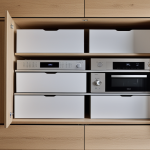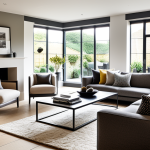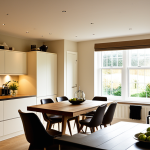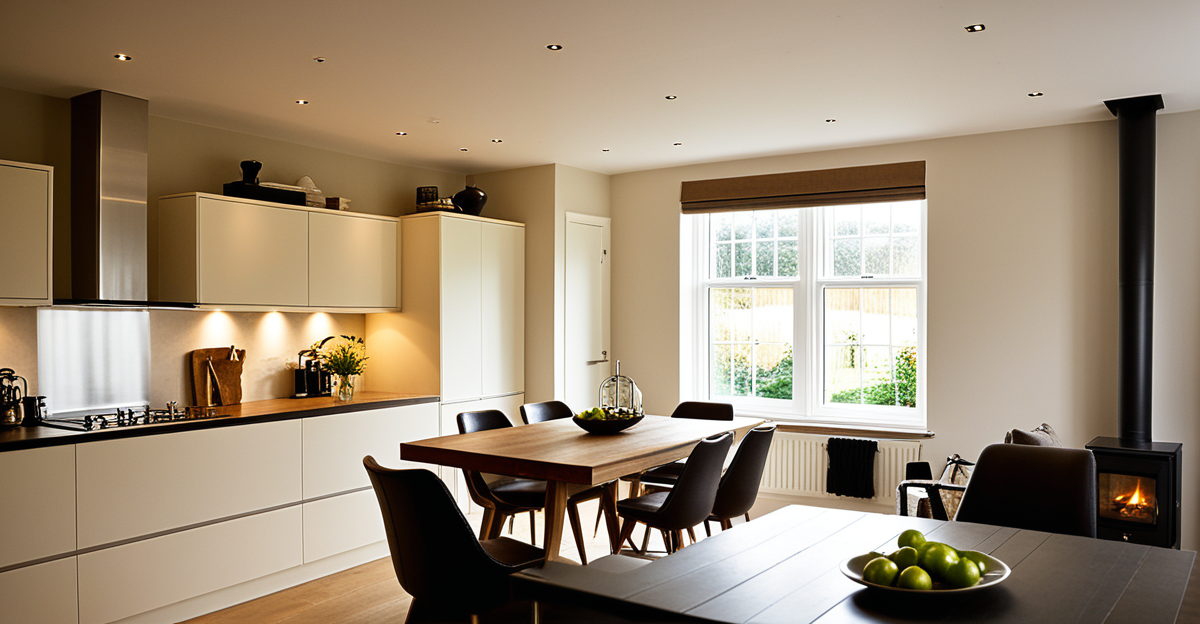Essential Principles for Enhancing Ambience with Lighting
Lighting plays a crucial role in shaping the ambience and overall mood of any space. Understanding how light influences atmosphere is the foundation of effective home lighting tips. Key factors include brightness, layering, and placement, each contributing uniquely to the desired feel. Brightness controls the energy in a room—a dimmer glow can create a cozy, intimate vibe, while brighter illumination boosts alertness and functionality.
Layering lighting is essential; this involves combining ambient light for general illumination, task lighting for specific activities, and accent lighting to highlight features. Proper layering avoids flat, uninviting spaces and adds depth. Placement matters too—lighting should be positioned to minimize shadows and glare, enhancing comfort and aesthetics.
Topic to read : How Can You Optimize Storage Solutions in Small UK Apartments?
Matching lighting to your interior design style ensures cohesion. For instance, minimalist décor benefits from sleek fixtures with hidden sources, while traditional interiors might call for ornate lamps or chandeliers. Adapting light fixtures to complement ambience not only elevates style but also reinforces your personal expression, making your home both inviting and visually balanced. These guiding principles form the heart of smart, effective lighting strategies.
Room-by-Room Lighting Recommendations for UK Homes
When considering lighting for rooms in UK homes, functionality and ambience must be balanced carefully. In the living room, lighting should offer both warmth and practicality. Combining dimmable ambient lights with task lamps near seating areas creates an adaptable environment suitable for relaxation or reading. Proper placement avoids harsh shadows and supports a welcoming vibe.
Also read : How Can Decorating Trends Enhance the Comfort of Your UK Home?
Kitchen lighting demands a focus on functionality without sacrificing atmosphere. Bright, shadow-free task lighting on work surfaces is essential for safety and efficiency during food preparation. Ambient lighting should complement these areas, using fixtures that spread light evenly without glare. Under-cabinet lights are a popular solution to illuminate countertops effectively.
For the bedroom, the goal is to foster relaxation while reflecting personal style. Soft, warm lighting tones work best here, promoting a calm ambience. Layered lighting allows changes from brighter light for dressing to low-level light for winding down. Adjustable bedside lamps combine style with practical use.
Bathrooms in the UK require lighting that ensures safety, especially in wet areas, while enhancing elegance. Bright, even lighting around mirrors helps with grooming tasks, paired with softer ambient light to create a spa-like feel. Waterproof fixtures conforming to UK safety standards are essential.
Essential Principles for Enhancing Ambience with Lighting
Lighting profoundly shapes a room’s ambience and mood. To enhance it successfully, consider key home lighting tips centered on brightness, layering, and placement. Brightness needs to be carefully controlled—not too harsh, to avoid discomfort, nor too dim, which can diminish functionality and feel gloomy.
Layering is another fundamental principle. Combine ambient, task, and accent lighting to create depth and flexibility. This allows you to adjust the atmosphere depending on different activities or times of day. For example, soft ambient lighting sets a relaxing tone, while well-placed task lights support focused activities.
Placement also critically affects ambience. Lights positioned too high or too low can cast unflattering shadows or glare. Instead, thoughtful placement enhances features and complements the room’s purpose and design.
Finally, matching lighting with your interior design style ensures cohesion. Contemporary spaces benefit from sleek fixtures and subtle LED highlights, while traditional rooms thrive with warm, ornate lamps. Applying these lighting principles ensures your home lighting tips result in a harmonious, inviting atmosphere.
Essential Principles for Enhancing Ambience with Lighting
Effective home lighting tips rely on understanding how light shapes the ambience of a space. Brightness is fundamental; dimmer settings create intimacy, while higher brightness encourages energy and focus. This balance directly influences mood and functionality.
Layering is another core lighting principle. Combining ambient, task, and accent lighting avoids flatness by adding depth and versatility. Ambient lighting provides general illumination; task lighting supports specific activities, and accent lighting highlights architectural or decorative features, enriching atmosphere.
Placement optimises light distribution, minimising harsh shadows and glare that can disrupt comfort and visual appeal. Choosing fixtures that coordinate with your interior design style enhances cohesion—sleek, minimal lighting matches modern spaces, while ornate pieces suit traditional rooms. This harmony reinforces ambience, making lighting an integral part of personal expression rather than a mere utility.
Together, these principles empower you to design lighting schemes that transform rooms, improve daily living, and reflect your style clearly and confidently.
Essential Principles for Enhancing Ambience with Lighting
Lighting fundamentally shapes a room’s ambience by influencing mood, comfort, and visual appeal. Applying key lighting principles ensures your space feels both inviting and functional.
First, controlling brightness is crucial. Too bright can cause discomfort, while too dim reduces usability. Adjustable dimmers are practical, letting you tailor light intensity based on activities or time of day. Next, layering lighting—combining ambient, task, and accent lights—adds depth and flexibility. Ambient lighting sets the overall mood, task lighting targets specific needs like reading or cooking, and accent lighting highlights architectural features or décor, creating focal points and texture.
Placement of lighting fixtures impacts shadows and glare, directly affecting ambience. For example, overhead lights may produce harsh shadows, so combining them with side lamps or wall sconces can create softer effects. Aligning lighting choices with your interior design style further enhances cohesion. Sleek, minimal fixtures suit modern homes, while classic lanterns or chandeliers complement traditional designs.
Incorporating these home lighting tips allows you to craft balanced, adaptable lighting schemes that elevate your living spaces.
Essential Principles for Enhancing Ambience with Lighting
Lighting fundamentally influences a room’s ambience, shaping mood and atmosphere. Brightness is the first crucial factor: a balanced level avoids both harsh glare and excessive dimness, fostering comfort and functionality. Proper control over brightness allows spaces to transition seamlessly from energetic daylight vibes to calm evening tones.
Next, layering remains a core lighting principle. Combining ambient, task, and accent lighting creates a versatile environment. Ambient light provides overall illumination, task lighting supports specific activities, and accent lighting highlights architectural features or décor. This mix prevents flatness and enriches the spatial experience, adapting easily to various uses and moods.
Placement of light sources directly impacts ambience by controlling shadows and glare. Optimal positioning ensures light complements the room’s functions and design. For example, avoiding overhead glare while illuminating seating areas enhances both appearance and comfort.
Finally, aligning lighting with your interior design style is essential. Whether sleek and modern or warm and traditional, coordinated lighting fixtures reinforce ambience and identity. Thoughtful application of these home lighting tips ensures your lighting enhances atmosphere while reflecting personality.
Essential Principles for Enhancing Ambience with Lighting
Lighting fundamentally influences a room’s ambience by shaping mood and atmosphere. The three core lighting principles to focus on are brightness, layering, and placement.
Brightness determines how a space feels—too intense lighting can cause discomfort, while too low brightness can reduce usability. Adjustable lighting solutions, such as dimmers, help tailor brightness effectively to different activities and times of day, enhancing both comfort and function.
Layering involves combining ambient, task, and accent lighting to create dynamic spaces. Ambient lighting provides overall illumination, task lighting supports specific needs like reading or cooking, and accent lighting highlights features, adding depth and visual interest. This layered approach avoids flatness and makes adapting the ambience easier.
Placement plays a crucial role in avoiding unflattering shadows or glaring light. Strategically locating fixtures ensures even light distribution, enhancing the room’s purpose and feel.
Finally, matching lighting with your interior design style ensures cohesion and harmony. Sleek, minimal fixtures complement modern décor, while ornate lighting fits traditional rooms, reinforcing the overall ambience. Following these home lighting tips allows you to craft inviting, functional spaces with confidence.
Essential Principles for Enhancing Ambience with Lighting
Lighting profoundly impacts a room’s ambience by influencing mood, comfort, and visual harmony. Key lighting principles begin with properly balancing brightness—too much can cause glare and discomfort, too little may leave a space dull and impractical. Adjustable dimming options enable flexible control, adapting the atmosphere to your needs throughout the day.
Layering lighting is fundamental to achieving depth and versatility. By blending ambient lighting for overall illumination, task lighting for specific activities, and accent lighting to highlight décor or architectural features, rooms gain texture and dynamic appeal. This approach prevents flat, uninspired spaces and allows atmosphere to shift easily.
Equally important is placement. Lighting must be positioned to soften shadows and avoid glare, enhancing visual comfort and drawing attention to design elements. For example, combining overhead lights with side lamps or wall fixtures can create balanced illumination and warm ambience.
Finally, aligning lighting choices with your interior design style ensures cohesive character. Contemporary homes benefit from sleek, minimal fixtures, while traditional settings call for warm, ornate designs. Thoughtful application of these principles elevates ambience, making lighting a personal and functional art form.
Essential Principles for Enhancing Ambience with Lighting
Creating the right ambience through lighting hinges on mastering three core lighting principles: brightness, layering, and placement. Brightness directly influences how a room feels—too bright can overwhelm, while too dim affects usability and mood. Using dimmers or adjustable fixtures allows fine control, enabling you to shift atmospheres from vibrant to subdued effortlessly.
Layering lighting combines ambient, task, and accent lights to enrich depth and adaptability. Ambient lighting sets the foundational tone, task lighting focuses on practical activities, and accent lighting emphasizes architectural or decorative details, enhancing visual interest. Integrating these layers ensures flexibility for different occasions or daily routines, making spaces more dynamic.
Placement is equally critical. Thoughtful positioning of fixtures avoids harsh shadows or glare that disrupt comfort and ambience. For example, side lamps soften corners, while overhead lights provide broad coverage—optimising balance is key.
Crucially, aligning your lighting choices with the interior design style ties everything together. Sleek, minimal fittings augment modern decor, while warm-hued, ornate fixtures suit traditional settings. These home lighting tips help create harmonious spaces where lighting and style complement each other seamlessly.
Essential Principles for Enhancing Ambience with Lighting
Lighting profoundly affects a room’s ambience, shaping mood and atmosphere through key lighting principles: brightness, layering, and placement. Controlling brightness is vital; it must be balanced to prevent glare and discomfort while maintaining functionality. Dimmers offer flexibility, enabling shifts from energizing daylight to soothing evening light, enhancing comfort and usability throughout the day.
Layering is essential to avoid flat, uninspired spaces. Combining ambient lighting for general illumination, task lighting for specific activities, and accent lighting to highlight décor or architectural features adds depth and allows adaptable atmospheres. This approach supports diverse needs, such as relaxing, reading, or entertaining, within the same space.
Placement of lighting fixtures directly influences ambience by controlling shadows and glare. Thoughtful positioning—like combining overhead lights with side lamps—softens harsh shadows and enhances visual comfort. Additionally, aligning lighting with your interior design style creates cohesion; sleek, minimal fixtures suit modern aesthetics, while ornate designs complement traditional décor. Employing these home lighting tips systematically ensures your lighting elevates atmosphere while reflecting your personal style effectively.







